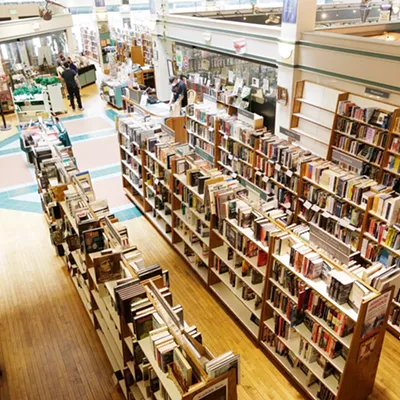Crammed in a narrow canyon of North Idaho's Silver Valley, in perhaps one of the most inconvenient but also beautiful places for a hub of human habitation, are the rusted remains of a once-lively mountain mine town.
Among the most famous ghost towns of the Inland Northwest, Burke has long attracted seekers of fortune, adventure and even the supernatural. Rich deposits of silver and lead were first discovered there in the 1880s, spurring a rapid boom of mining and development, the remnants of which still linger in decay.
Looming on the steep east slope of Burke Canyon is the most striking reminder of its reputation as one of the Silver Valley's richest mining hubs. The towering, deteriorating buildings of brick, concrete and sheet metal, some connected by covered catwalks, were once the site of the Hecla Star Mine, which closed in 1991. Behind a tall chain link fence topped with barbed wire is the place where thousands of miners once embarked deep underground to undertake the arduous and unforgiving physical labor of hard-rock mining.
The canyon was once home to three mines operating simultaneously, the Hecla (later named Hecla Star), Tiger-Poorman and Hercules. It's from these rich deposits that many of Spokane's wealthiest early families — Campbell, Clark, Finch, Hutton and Paulsen — made their fortunes.
While several residences along the winding canyon road are still occupied, a lone two-story wooden house collapsing on a forested hill can be spotted from the road near the Star Mine's south end. Farther down the extremely narrow road once shared by trains, cars, wagons and pedestrians (Burke's Tiger Hotel even famously straddled the railroad tracks) are a few more boarded-up buildings. These crumbling, single-story brick structures are all that remains of what once was the Morrow Retail Store, its painted signage barely perceptible, and a post office. A steep, rocky hillside behind is still pierced by the rotting splinters of wooden railroad ties.

In its heyday, Burke was abuzz with activity.
A wealth of historic photos depict a town filled with shops and homes, a stately multistory school, a baseball field, and even a public swimming pool built by Hecla Mining Company for area families to enjoy.
By the late 1940s, as described in The Silver Valley (Images of America), a book compiled by the Historic Wallace Preservation Society, Burke had at least eight bars, plus separate clothing stores for men and women, barber and beauty shops, a grocer, churches, a theater, and several restaurants.
As with countless towns in the American West, however, Burke was also familiar with tragedy and unrest.
Established: 1887
Decline: Burke's last mine, the Hecla Star, closed in 1991. There are still numerous occupied residences through Burke Canyon.
Location: Shoshone County, Idaho
Distance from Spokane: 87 miles; 1.5 hours
Structures remaining: Multiple large structures at the Star Mine and a handful of brick buildings along the highway.
In 1892, labor tensions came to a head due to pay disputes and several area mines' hiring of replacement workers during a union strike. During a gunfight down the canyon from Burke at the Frisco mine and mill, after union miners discovered a spy in their ranks, a box of dynamite exploded and killed six. Tensions boiled up again in 1899, and this time the Bunker Hill Mine in Wardner was targeted. A train set out from Burke, picking up more union miners and loads of dynamite along the way before detonating their payload at the mine. The U.S. military responded to both incidents.
Deadly avalanches, fires and floods also plagued Burke over the years, destroying buildings, homes, and taking lives.
According to U.S. Census records, the town's population peaked at about 1,400 in 1910, yet steadily declined in the decades to follow. By 1990, only 15 residents were counted. While more recent census data doesn't specifically list Burke's population, the canyon north of Wallace is still sparsely inhabited even if the town itself is no more.
An eerie emptiness is palpable in the long shadows of the mountains and abandoned mine site. Aside from a glimpse at its faded past, some visitors to Burke seek a brush with the supernatural.
Spokane-based paranormal investigator Amanda Paulson (she's on all social media platforms as prettyfnspooky) has been to the storied canyon numerous times.
"In terms of the paranormal, there is absolutely stuff going on out there," Paulson says of the whole area around Burke and nearby Wallace. "I do think there are a lot of different phenomena happening out there. But I also feel extremely protective of it. But being online, when I'm protective of something I want to actually put eyes on it, and have a lot of other people care about it, too, because I think we can protect resources like that." ♦
Editor's Note: A four-year project by the Environmental Protection Agency to remove heavy metals-contaminated soil from the Hecla Star Mine complex is currently underway (estimated completion is late 2026) and access to Burke is limited. Potential visitors are asked to be mindful of ongoing work, including increased truck traffic, along the narrow canyon road during the construction season (May-Nov.). An EPA spokesperson says efforts are being made to minimize impacts to the historic structures while achieving cleanup goals.























